![]()
![]()
![]()
Use LEFT and RIGHT arrow keys to navigate between flashcards;
Use UP and DOWN arrow keys to flip the card;
H to show hint;
A reads text to speech;
28 Cards in this Set
- Front
- Back

|
Palace of Minos. Knossos, Crete. Minoan Columns. Date: 1500 BCE. Pillowy Tops. Frescoes. No linear axis. Resembled the Labyrinth of myth. |
|
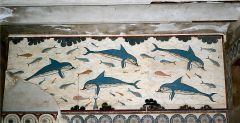
|
Queen's Megaron. Palace of Minos. Knossos, Crete. Date: 1700-1300 BCE. Playful paintings. Resembling nature and active. HALLMARKS OF MINOAN ART: Uses entire area and has a frame. |
|
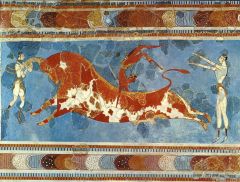
|
Toreador Fresco. Palace of Minos. Knossos, Crete. Minoan Period. Date: 1550-1450 BCE. Men shown darker than women. Playful. Active. Composite view. Thin and small people. |
|
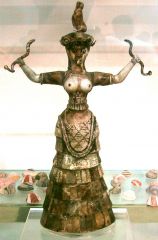
|
Snake Goddess. Palace Complex, Palace of Minos. Minoan Period. Knossos, Crete. Date: 1650 BCE. Made of FAIENCE. Vitreous sand that has been hardened and covered in glaze. Material is manmade. |
|

|
Harvester Vase. Minoan Period. Date: ca. 1500-1450 BCE. Medium: Stone/Steatite. |
|
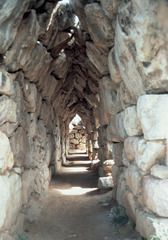
|
Corbeled Casemate. Mycenean Period. Cylopean Masonry. 1400-1280 BCE. Each course of stone projects a little more inward than the row below it. |
|
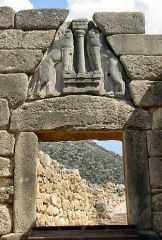
|
Lion Gate. Mycenaean Period. 1250 BCE. Relieving Arch. Flanking a Minoan Column. Corbeled Relieving Arch. |
|
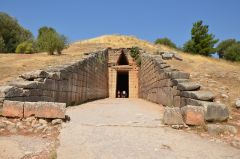
|
Treasury of Atreus. 1300-1250 BCE. Long passageway called a DROMOS. Thollos or Beehive style tomb. Body was placed either underground or in an adjacent room. |
|
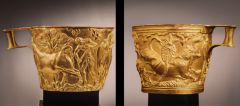
|
Vaphio Cups. 1500-1450 BCE. Mycenean Period. Gold, using the method of Repousse'. One of them depicts a peaceful Minoan landscape. One of them depicts a violent Mycenean scene. |
|
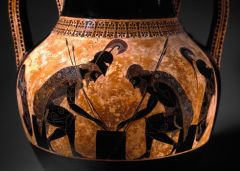
|
Achilles and Ajax Playing Dice. 560-530 BCE. Arcahic Period. Artist: EXEKIAS. Black figures painted onto red clay amphoras and then etched. |
|
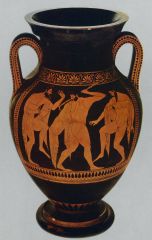
|
Dancing Revelers. (Komasts) 510-500 BCE. Red-Figured Amphora. Figures painted, not etched onto the red clay amphoras. |
|
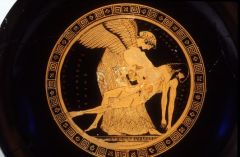
|
Eos and Memon. Artist: Douris Painter. ca. 490-480 BCE. Red-Figured. |
|
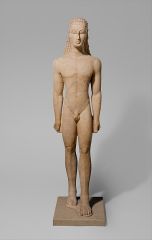
|
Kouros (Youth). Date: ca. 600-590 BCE. Funerary marker for a deceased noble youth. Pose influenced by Egyptian Old Kingdom Portraits. |
|
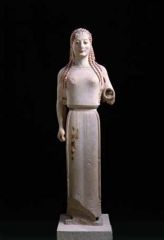
|
Peplos Kore. Female Funerary Figure. Dressed. |
|

|
Kritios Boy. Date: 490-480 BCE. CONTRAPOSSTO. All weight resting on one leg. Hips and Shoulders at different levels. |
|
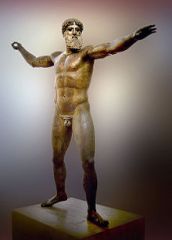
|
Early Classical Period. Zeus or Poseidon. Lost Wax Method. 460-450 BCE. Transitory moment. |
|

|
Doryphoros. (Spear Bearer). ARTIST: POLYKLEITOS. 450-440 BCE. High Classical Period. Established canon of proportions; 1:7, head to body. Idealized with no expression is the hallmark of high classical period. |
|
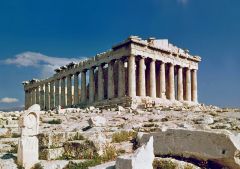
|
The Parthenon. 447 BCE-432 BCE. ARCHITECTS: IKTINOS & KALLIKRATES. Dedicated to Athena. Meant to be approached on a diagonal. Structure included many Pediments. Doric structure. |
|
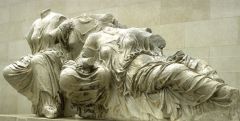
|
Three Goddesses. Parthenon Pediments. |
|

|
Inner Frieze. Parthenon. Pan-Athenaic Procession or the Sacrifice of Arechtheus' Daughters. Peplos, or funerary cloth. EASTERN FRIEZE. |
|
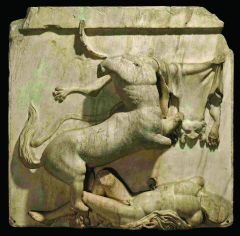
|
Lapith and Centaur Metope. SOUTHERN FRIEZE. Symbolized the real battle that happened between the Persians and Athenians. |
|

|
Doric |
|
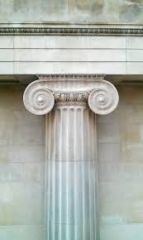
|
Ionic |
|
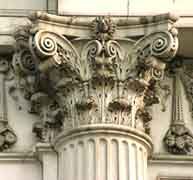
|
Corinthian. |
|
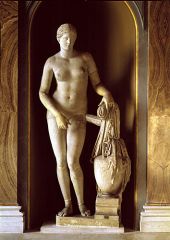
|
Aphrodite of Knidos. Artist: PRAXITELES. ca. 340 BCE. Totally idealized. Roman copy of greek original. Modeled after; PHRYNE the courtesan. |
|
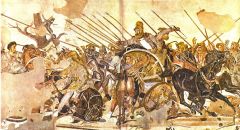
|
The Battle of Alexander. Hellenistic Period. 323 BCE-31 BCE. Medium: Mosaic. Dynamic and dramatic. |
|
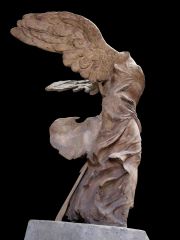
|
Nike of Samothrace. 190 BCE. Commemorates a naval victory. ARTIST: Pythokritos or other rhodes sculptor. Movement. S-Torsion. Cloth Draperies blowing in the natural wind of the statue's location. |
|
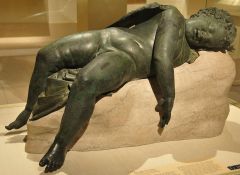
|
Sleeping Eros. 240-200 BCE. Garden Decoration. Lost Wax Method. Sleeping figures were popular in the Hellenistic Period. Cast Bronze. Wing details; similar to Nike of Samothrace. |

